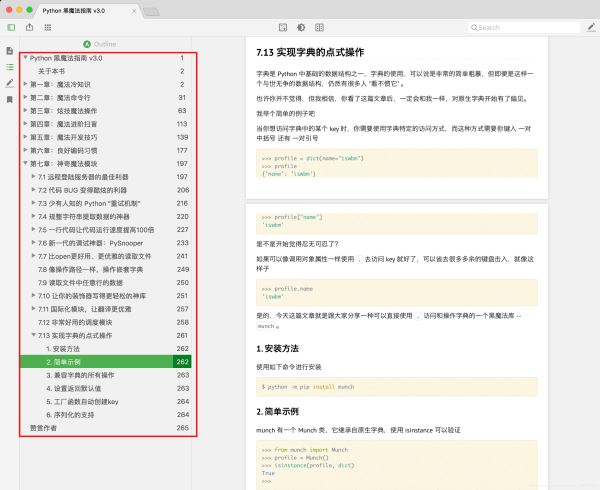本篇内容主要讲解“Python黑魔法库安装及操作字典的方法教程”,感兴趣的朋友不妨来看看。本文介绍的方法操作简单快捷,实用性强。下面就让小编来带大家学习“Python黑魔法库安装及操作字典的方法教程”吧!
当你想访问字典中的某个 key 时,你需要使用字典特定的访问方式,而这种方式需要你键入 一对中括号 还有 一对引号
>>> profile = dict(name="iswbm")
>>> profile
{'name': 'iswbm'}
>>> profile["name"]
'iswbm'是不是开始觉得忍无可忍了?
如果可以像调用对象属性一样使用 . 去访问 key 就好了,可以省去很多多余的键盘击入,就像这样子
>>> profile.name
'iswbm'是的,今天这篇文章就是跟大家分享一种可以直接使用 . 访问和操作字典的一个黑魔法库 – munch。
使用如下命令进行安装
$ python -m pip install munchmunch 有一个 Munch 类,它继承自原生字典,使用 isinstance 可以验证
>>> from munch import Munch
>>> profile = Munch()
>>> isinstance(profile, dict)
True
>>>并实现了点式赋值与访问,profile.name 与 profile['name'] 是等价的
>>> profile.name = "iswbm"
>>> profile.age = 18
>>> profile
Munch({'name': 'iswbm', 'age': 18})
>>>
>>> profile.name
'iswbm'
>>> profile["name"]
'iswbm'本身 Munch 继承自 dict,dict 的操作也同样适用于 Munch 对象,不妨再来验证下
首先是:增删改查
# 新增元素
>>> profile["gender"] = "male"
>>> profile
Munch({'name': 'iswbm', 'age': 18, 'gender': 'male'})
# 修改元素
>>> profile["gender"] = "female"
>>> profile
Munch({'name': 'iswbm', 'age': 18, 'gender': 'female'})
# 删除元素
>>> profile.pop("gender")
'female'
>>> profile
Munch({'name': 'iswbm', 'age': 18})
>>>
>>> del profile["age"]
>>> profile
Munch({'name': 'iswbm'})再者是:一些常用方法
>>> profile.keys()
dict_keys(['name'])
>>>
>>> profile.values()
dict_values(['iswbm'])
>>>
>>> profile.get('name')
'iswbm'
>>> profile.setdefault('gender', 'male')
'male'
>>> profile
Munch({'name': 'iswbm', 'gender': 'male'})当访问一个字典中不存在的 key 时,会报 KeyError 的错误
>>> profile = {}
>>> profile["name"]
Traceback (most recent call last):
File "<stdin>", line 1, in <module>
KeyError: 'name'对于这种情况,通常我们会使用 get 来规避
>>> profile = {}
>>> profile.get("name", "undefined")
'undefined'当然你在 munch 中仍然可以这么用,不过还有一种更好的方法:使用 DefaultMunch,它会在你访问不存在的 key 时,给你返回一个设定好的默认值
>>> from munch import DefaultMunch
>>> profile = DefaultMunch("undefined", {"name": "iswbm"})
>>> profile
DefaultMunch('undefined', {'name': 'iswbm'})
>>> profile.age
'undefined'
>>> profile
DefaultMunch('undefined', {'name': 'iswbm'})上面使用 DefaultMunch 仅当你访问不存在的 key 是返回一个默认值,但这个行为并不会修改原 munch 对象的任何内容。
若你想访问不存在的 key 时,自动触发给原 munch 中新增你想要访问的 key ,并为其设置一个默认值,可以试一下 DefaultFactoryMunch 传入一个工厂函数。
>>> from munch import DefaultFactoryMunch
>>> profile = DefaultFactoryMunch(list, name='iswbm')
>>> profile
DefaultFactoryMunch(list, {'name': 'iswbm'})
>>>
>>> profile.brothers
[]
>>> profile
DefaultFactoryMunch(list, {'name': 'iswbm', 'brothers': []})Munch 支持序列化为 JSON 或者 YAML 格式的字符串对象
转换成 JSON
>>> from munch import Munch
>>> munch_obj = Munch(foo=Munch(lol=True), bar=100, msg='hello')
>>>
>>> import json
>>> json.dumps(munch_obj)
'{"foo": {"lol": true}, "bar": 100, "msg": "hello"}'转换成 YAML
>>> from munch import Munch
>>> munch_obj = Munch(foo=Munch(lol=True), bar=100, msg='hello')
>>> import yaml
>>> yaml.dump(munch_obj)
'!munch.Munch\nbar: 100\nfoo: !munch.Munch\n lol: true\nmsg: hello\n'
>>>
>>> print(yaml.dump(munch_obj))
!munch.Munch
bar: 100
foo: !munch.Munch
lol: true
msg: hello
>>>建议使用 safe_dump 去掉 !munch.Munch
>>> dict_obj = {"1.2": "hello"}
>>> dict_obj["1.2"]
'hello'以上就是关于 munch 的使用全解,munch 的进一步封装使得数据的访问及操作更得更加 Pythonic ,替换原生字典在大部分场景下都不会有太大问题。
但同时也不得不承认,munch 在一些场景下无法达到原生字典的效果,比如我想字典里的 key 为 "1.2" 的时候,原生字典能很好的表示它。
>>> dict_obj = {"1.2": "hello"}
>>> dict_obj["1.2"]
'hello'切换到 munch ,你会发现无法在初始化 munch 对象的时候,传入 1.2 的 key
>>> from munch import Munch
>>> dict_obj = Munch(1.2="hello")
File "<stdin>", line 1
dict_obj = Munch(1.2="hello")
^
SyntaxError: expression cannot contain assignment, perhaps you meant "=="?就算你用原生的字典的方式添加了这个 key-value,也根本无法使用 . 的方式取到 1.2 对应的 value。
>>> from munch import Munch
>>> dict_obj = Munch()
>>> dict_obj["1.2"]="hello"
>>> dict_obj
Munch({'1.2': 'hello'})
>>> dict_obj.1.2
File "<stdin>", line 1
dict_obj.1.2
^
SyntaxError: invalid syntax也正是因为这样,原生字典至今还是不可替代的存在。
以上就今天跟大家分享的内容,这篇文章是《Python黑魔法手册》 v3.0 版的最后一篇文章,目前 PDF 已经制作完成。

到此,相信大家对“Python黑魔法库安装及操作字典的方法教程”有了更深的了解,不妨来实际操作一番吧!这里是亿速云网站,更多相关内容可以进入相关频道进行查询,关注我们,继续学习!
亿速云「云服务器」,即开即用、新一代英特尔至强铂金CPU、三副本存储NVMe SSD云盘,价格低至29元/月。点击查看>>
免责声明:本站发布的内容(图片、视频和文字)以原创、转载和分享为主,文章观点不代表本网站立场,如果涉及侵权请联系站长邮箱:is@yisu.com进行举报,并提供相关证据,一经查实,将立刻删除涉嫌侵权内容。